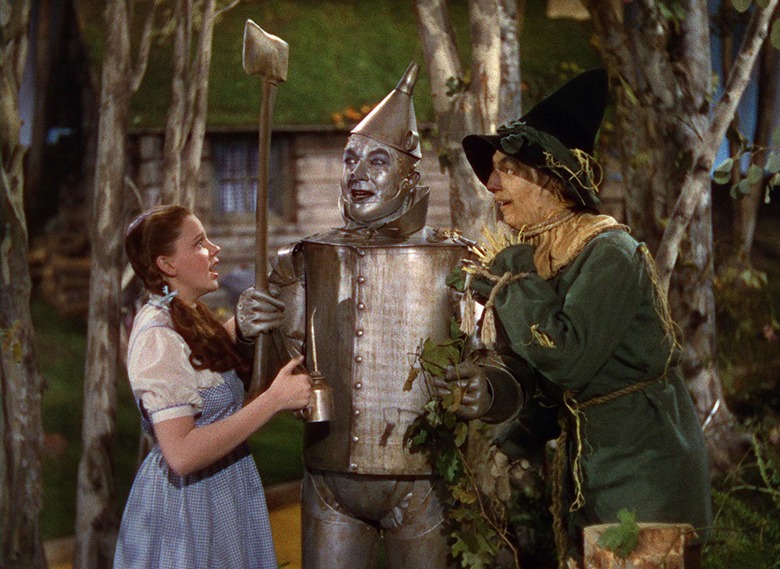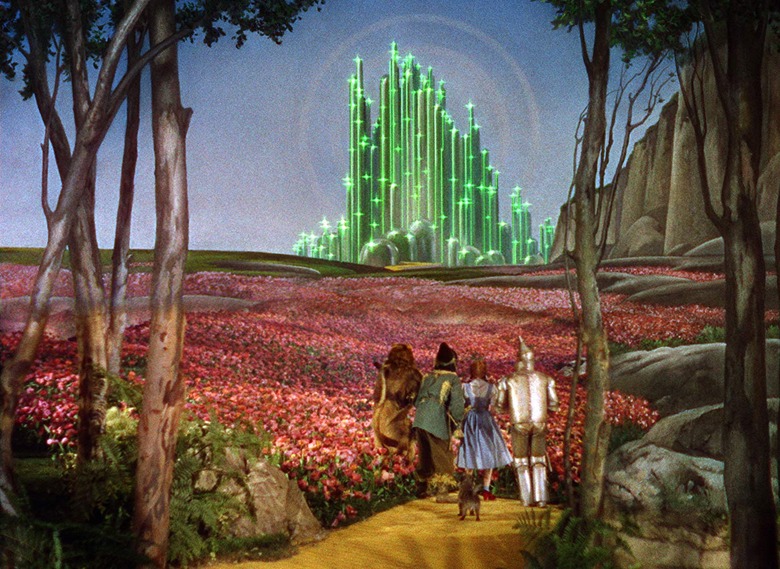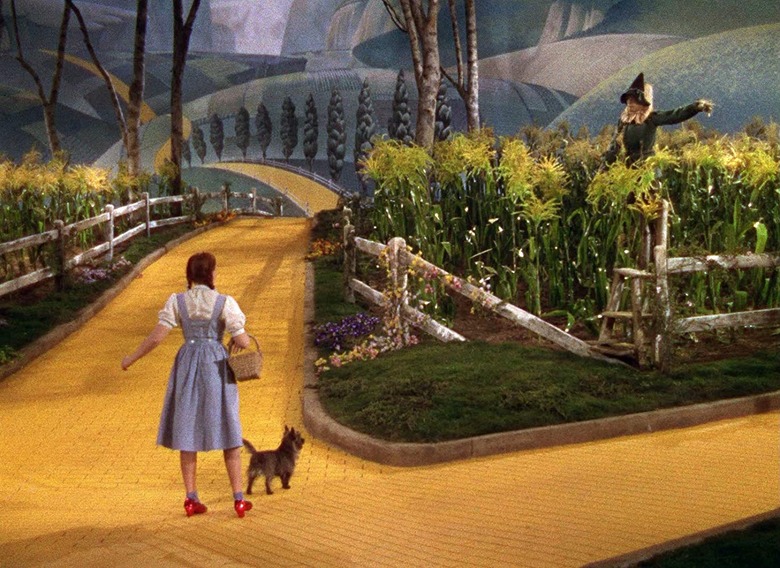'The Wizard Of Oz' Revisited: How The 1939 Masterpiece Became A Cinematic Classic For The Ages
(Welcome to 1939: Revisited, a column dedicated to taking a look back at some of the films of one of the most highly-praised years in film history and explaining why they still matter today. In this inaugural entry: Jessica Mason takes a whirlwind twister ride and revisits The Wizard of Oz.)
We live in a world with more movies and television available than we could ever hope to consume. With so much media all around us, it's easy to forget a time when television didn't even exist and movies were an event as exciting as a Broadway show, and sometimes just as hard to see. How we see movies nowadays is so different from how they were viewed in the so-called Golden Age of Hollywood, but the films of that era still loom large over our cultural landscape.Classic films exist as a shared iconography, their influence extending so deep into our imaginations that we may not even know how important they were until we take a deeper look. And an astonishing amount of iconic films debuted in the year 1939: The Wizard of Oz, Gone with the Wind, Stagecoach, The Women, Ninotchka, Mr. Smith Goes to Washington, and more. Eighty years later, the films of 1939 still matter, not just because of what they achieved at the time, but how they influenced and continue to impact culture to this day. This series will explore the classics of 1939 with 80 years of perspective; how they came to be, their influence on media, and what they still have to say. Since we're looking at iconic movies, there's no better film we could start with than The Wizard of Oz.
Truly “Wonderful”
Last year, a study at the University of Turin caused a stir when it crowned The Wizard of Oz the most influential movie of all time. While the top spot might be debatable, the prominence of Oz in our culture can't be ignored. Every song, character, and image from the film is iconic, from the ruby slippers that now rest in the Smithsonian, to a band named after Dorothy's dog singing about blessing rains, to the rainbow flags that represent pride. Because of its ubiquity, we tend to think of The Wizard of Oz as this perfect, eternal thing, like a Da Vinci painting or a national park. It looms so large in our collective consciousness that it's almost impossible to contemplate a world without it. But we lose something when we look at Oz without the context of when and how it was made.More than anything, The Wizard of Oz represents an escape, a grand dream of something magical that could take audiences, well, over the rainbow from their not-so-fairytale lives. Things in America, and the world, were fraught in 1939. War was brewing, and the Great Depression and the Dust Bowl droughts were still current events. Their subtext in the images of dirty farm hands, missing parents, and barren Kansas landscapes lurk around the edges of the world Dorothy wants to escape. The original Oz story was created by a traveling salesman named L. Frank Baum, whose own character is likely best represented by the Wizard himself (or maybe Professor Miracle). The Wonderful Wizard of Oz, published in 1900, was Baum's own escape from a series of failed endeavors and false starts. He rode the success of the book and its many sequels as far as they would take him, even into early motion pictures. But those first movie attempts were actually flops, and he ended up selling the rights to the story when he hit financial troubles. It took a while, and a big risk, for Oz to take flight.
Traveling By Twister: The Trials and Tribulations of Making Oz Real
Given the failures of other Oz-related moving pictures, a new version of the story was far from a sure thing. In the '30s, fantasy films weren't really a thing; at least not in the way we know them now. The idea of cinematic entertainment for children with a magical element was new, and was boosted by another film we still feel the influence of today: 1937's Snow White and the Seven Dwarfs. The success of Snow White is very likely one of the main factors that pushed MGM into making Oz. And to understand how The Wizard of Oz was made and why it was such an achievement, you need to understand MGM.The thirties was arguably the apex of the studio system in Hollywood, when a few powerful corporations controlled development, production, and distribution of nearly all films and kept their workers, from carpenters to actors and directors, on contract. These were factories, and their products were moving pictures. Of these behemoths, MGM was the gold standard. They had the brightest stars, the highest production values, the biggest sets, and the clearest brand as the epitome of filmmaking. It was because of this environment – where a film belonged to a studio, not an individual writer, director or star – that The Wizard of Oz was such a good film. But it also became one of the biggest and most troubled productions in Hollywood at the time.Though the rumor that a Munchkin committed suicide on the set is a just an urban myth, it was a grueling and painful shoot. The three-strip technicolor shooting process meant the lighting had to be incredibly bright, and temperatures in the studio soared to 100 degrees. Heavy costumes and uncomfortable make up were a bane for everyone. Buddy Ebsen was initially cast as the Tin Man before the make up sent him to the hospital for weeks, and Margaret Hamilton was seriously burned by pyrotechnics during the Wicked Witch of the West's fiery exit from Munchkinland. Add in a cast of little people that liked to party and a young star already being pushed past her limits, and the land of Oz was hardly magical. Judy Garland would regale audiences with tales of the shoot for years, but the shadow of Oz was something Garland was never able to shake.The Wizard of Oz went through four directors, starting with Richard Thorpe, who left a month into filming. George Cukor subbed in for a week, long enough to get Judy Garland out of a blonde wig. Cukor ceded the reins to Victor Fleming, the only credited director, who shot about 80% of the film before he had to take over on another massive production that we'll discuss in detail later in this series – Gone with the Wind. The final scenes were shot by King Vidor, including the iconic "Over the Rainbow" number...which almost ended up on the cutting room floor. Fleming wanted to cut it, thinking that it slowed down the pacing early in the film. The song was saved by Louis B. Mayer, the head of MGM, and the rest, you'd assume, is history.
The Long Yellow Brick Road to Becoming a Classic
Not quite. Oz was marketed hard, with studio press building buzz for months before its release. The film had a big debut, with huge crowds lining up at theaters early in the run. It won two Oscars and made Judy Garland an even bigger star, but it wasn't a runaway hit. The budget for The Wizard of Oz was massive for the time and ended up at $2.8 million (roughly $53 million in today's dollars), a million more than planned. Add in the marketing and distribution costs, and even though many people saw the film and it took in $3 million at the box office, it took ten years for Oz to break even. So how did it become so iconic?Television. Starting in 1956, The Wizard of Oz began to air on the relatively new medium, and became an annual tradition for families around the country. It was also one of the first films MGM ever released on VHS. (It was the first film my family bought on tape.) Like so many children over the years, The Wizard of Oz was my introduction to the movies. It's the perfect movie for kids because it so viscerally understands the magic of imagery, color, and song. The Wizard of Oz endures because it is both simple and incredibly complex in execution.Here's what I mean by complexity: Oz is an icon of the studio system and the communal nature of filmmaking in general. Thousands of people worked on this film, and gave it every ounce of their focus and energy. Costume designer Adrian Greenburg created thousands of designs and sourced materials from the whole country. New methods of make-up and special effects were invented for the film. Despite the fraught production, each actor and creator gave their all and it shows on screen. You can watch the crowd scenes a hundred times and always find new details. The story and songs never get old because they're archetypal in how they express longing – for escape, for knowledge, or love, or courage. The message of The Wizard of Oz is that what we're looking for has been with us all along, and that's a profound statement to contemplate, especially nowadays when we're obsessed with our own influence and constantly seeking the next hit of engagement.Eighty years on, The Wizard of Oz still stands as an icon of craft and the power of movies. For me, the moment that still amazes the most is one of the simplest: when Dorothy walks out of her displaced house and into Oz, from sepia to Technicolor. The Wizard of Oz wasn't the first film to move from black and white to color for dramatic effect, but it had never been done so well or communicated something so powerful – the magic of a new world. From the long history of the story, the troubled development, and box office disappointment to its cult status and ascent into legend, The Wizard of Oz serves as a template for so many films after it. Eighty years later, we're still following the yellow brick road these filmmakers laid for us and looking for a new Oz in which to escape. But maybe we'll find, like Dorothy, that our heart's desire was right there with us all along.



